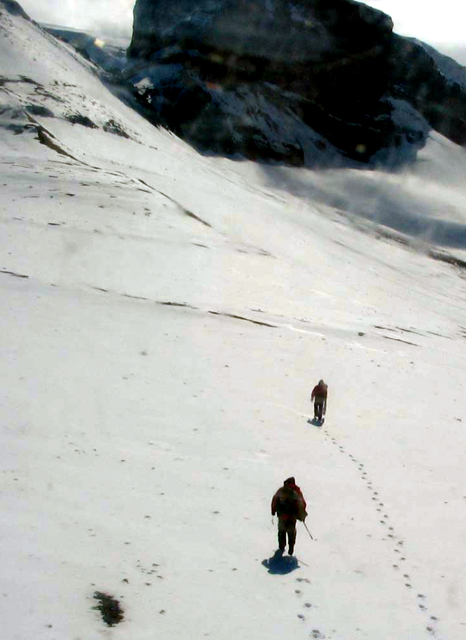|
Page 2/2 - Posted June 5, 2009
Ground zero for bird originationIn fact, the paleontologists believe this region may have been ground zero for modern bird evolution, or at least a major hotspot. The hypothesis is based largely on the biogeography, the distribution of existing bird groups, an idea that dates back to the 1970s, according to Clarke. “That idea has been around for a long time,” she said, but the fossil evidence hasn’t been collected and evaluated in a systematic fashion, as she and her team proposes to do, to put it to the test. Dinosaurs in Antarctica
NSF Special Report:
Digging Dinosaurs Previous Sun coverage: Dec. 24, 2006 June 21, 2004 Case said evidence is mounting for such a scenario, especially given the Southern Hemisphere origination of lineages for penguins and ratites (such as ostriches and emus). “If you throw those lines in with [the other pre-K-T boundary lineages], it clearly begins to allow for the hypothesis, and add some strength to the idea, that somewhere deep in Gondwana, modern birds originated.” Gondwana is the southern supercontinent that at one time included Antarctica, South America, Africa, Madagascar, Australia-New Guinea and New Zealand. By the late Cretaceous, Antarctica had moved into its current position, though still tenuously connected to Australia and South America. The climate would have been quite moderate, according to Case. “Where today [Antarctica] seems pretty stark … back in this timeframe, it was a very rich, vibrant place,” he said. “The contrast of what it was to what it is today is pretty dramatic. I can’t think any place else on the Earth as dichotomous. “We’re looking at cool, temperate waters, certainly not much different than what we see off the west coast of the United States, at least until you get to southern California,” he added. “We don’t expect marine reptiles to have a lot of blubber, like marine mammals do, so it’s got to be warm enough that the young with small body sizes can survive comfortably.” Clarke said that while there appears to be good evidence emerging from the Antarctic Peninsula fossil record to suggest a Southern Hemisphere origination, she cautioned that the sampling size is still relatively small. “We’re going to be able to be able to offer more data than has ever been put forward on what’s really in Antarctica during this time period, but we’re not going to be able to answer this question definitively,” she said. Breaking rocks digitallyClarke’s expertise is phylogenetic analysis from morphological data, meaning she studies the evolutionary relatedness among birds by comparing the physical changes that occur over time. A very useful tool in acquiring the data she needs for the research is a high-resolution X-ray CT scanner. CT scans offer a noninvasive way for peering into solid objects and for obtaining digital information on their 3-D geometries and properties. High-resolution X-ray CT differs from conventional medical CAT-scanning in its ability to provide details down to the tens of microns — less than the width of a hair. The NSF supports the High-Resolution X-ray Computed Tomography Facility Clarke said the scans save time and allow scientists to manipulate the data in new ways. “CT scans are really useful in this case because a lot of the rocks in which these remains are preserved are incredibly hard,” she explained. “It’s months and months and months of moving individual sand grains to prepare these things. You can see the interiors of elements. You could see morphologies that would never be exposed even if you didn't have those tools. “There were bones that were discovered in that Vegavis specimen that we had no idea were in there,” she added. In addition, one of her students is digitally extracting individual bones from the original Vegavis scan, which appears online like the silvery half of an oversized grapefruit, with the ancient bird bones prominently sticking out. Work has already begun on the fossils from Argentina, Texas Tech, the South Dakota School of Mines and elsewhere. Eventually, the team plans to publish a monograph, a sort of comprehensive essay, which describes the Antarctic materials, with a photo library of all the remains with preliminary identifications, according to Clarke. “We’re making progress,” she said. Case said the researchers would propose further fieldwork to look specifically at bird fossils and the question of whether that part of Gondwana was indeed the cradle for modern birds. “It’s one of the biggest questions out there right now,” he said. NSF-funded research in this story: Julia Clarke, University of Texas at Austin, and Judd Case, Eastern Washington University, Award No. 0731404 |



For USAP Participants |
For The Public |
For Researchers and EducatorsContact UsU.S. National Science FoundationOffice of Polar Programs Geosciences Directorate 2415 Eisenhower Avenue, Suite W7100 Alexandria, VA 22314 Sign up for the NSF Office of Polar Programs newsletter and events. Feedback Form |



